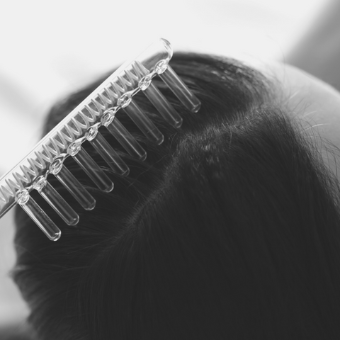In recent years, we’ve seen an overlap between the skin care and hair care industry—a new approach to hair and scalp care consisting of skin care-inspired products and treatments. After all, the scalp is skin!
During the pandemic, scalp and hair issues became more prominent—particularly hair loss—and as a result, the “skin-ification” of hair care is booming. In fact, skin care brands are now branching out into hair care. Before we dive into some of the popular skin care treatments for hair loss and scalp issues, let’s touch on some of the causes of hair loss.
Causes of Hair Loss
Hair challenges, including hair loss and shedding, should be viewed as a combination of factors. Although a certain amount of hair loss is normal, here are some factors that can cause extensive hair loss:
- Poor Scalp Health: One of the most common reasons for thinning hair is poor scalp health. This includes dead cell build up, poor circulation, clogged follicles, and poor hydration. Additionally, you may have a client suffering from scalp health issues such as psoriasis or seborrheic dermatitis (a.k.a. dandruff), which can contribute to thinning of the hair.
- Hormonal Changes: Hair loss is often associated with thyroid conditions, but is also linked to changes in estrogen and testosterone due to birth control, pregnancy, and menopause. Other hormonal imbalances can also play a role.
- Diet: An unhealthy diet, yo-yo dieting, and lacking vital nutrients all play a role in the health of hair and the skin. Biotin, iron, vitamin C, vitamin D, and zinc are all known to benefit hair.
- Genetics, Age, and Illness: According to the Cleveland Clinic, 30 percent of women experience genetic hair loss, known as female pattern hair loss. This is gradual and will get worse with age. As we age, our hormone levels change, and thinning hair or a receding hairline is common.
- Temporary hair loss is normal after a fever or illness and is referred to as telogen effluvium. A fever or illness, like what occurs during COVID, can force hairs into the shedding phase. This is temporary and resolves within months.
- Temporary hair loss is normal after a fever or illness and is referred to as telogen effluvium. A fever or illness, like what occurs during COVID, can force hairs into the shedding phase. This is temporary and resolves within months.
- Stress: An increase in stress releases cortisol and sometimes results in thinner hair, shedding, or in extreme situations, the hair coming out in clumps. Stressful life events like the COVID pandemic can lead to extreme stress and depression, which contributes to hair loss. Usually this is reversable.
- Styling Damage: Concentrated heat, chemicals, and tight hair styles all contribute to inflammation in the scalp.
Skin Care Treatments for Hair Loss
- Collagen Induction Therapy/Microneedling: While used as an antiaging skin treatment, microneedling may also be a method of treatment for hair loss. The same process of creating wounds in the skin is also thought to regenerate the health of the hair follicles. This procedure can be combined with the guest’s platelet-rich plasma (PRP), which contains active growth factors and can promote hair growth.
- HydraFacial Scalp Treatment: This treatment cleanses, exfoliates, and hydrates the scalp and hair follicles. It also removes dirt, oil, flakes, dead skin cells, and impurities from the surface of the scalp and from hair follicles. It stimulates scalp circulation and infuses the scalp and hair follicles with growth factors and skin proteins to promote the appearance of healthier, thicker, fuller-looking hair. It is recommended for everyone, regardless of skin and hair types. Whether someone has thin, brittle hair or an oily scalp, the treatment can address any need.
- Scalp Micropigmentation: For those guests who want an immediate result and the look of thicker, fuller hair, scalp micropigmentation is a noninvasive treatment that uses micro-needles to deposit pigment into the scalp. The result creates the appearance of tiny hair follicles that help thicken and restore the look of fuller hair. This treatment is for both men and women. Men can achieve the look of a buzz cut or eliminate a receding hair line. Women can avoid the look of thinning hair by creating the illusion of tiny hair follicles.
- Fractional Laser Therapies: Laser therapy has been reported to increase hair growth and activate hair follicles. Nonablative fractional lasers create microchannels in the skin like microneedling and may be accompanied with a hair growth serum.
It is important to always stay within your scope of practice. Each state has different rules and regulations, and it is not uncommon that estheticians may not be able to touch the hair or the scalp. Further, if you are performing pigment procedures or laser procedures, some states may require a secondary license or a medical director to oversee these procedures.
- Log in to post comments

